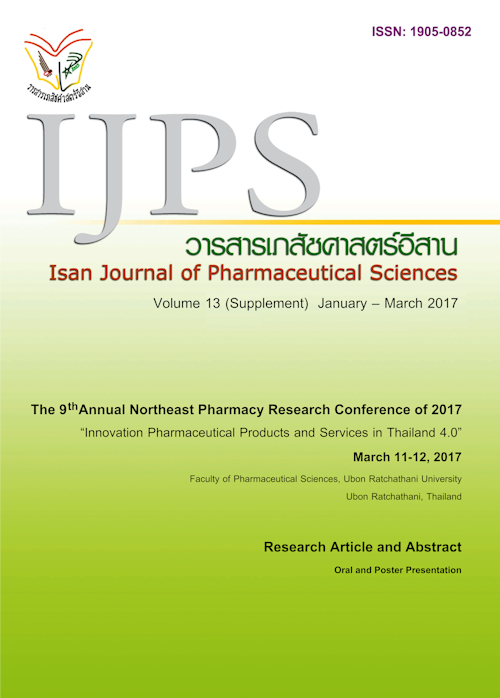Effect of sweetening agents and disintegrating agenton the properties of oral disintegrating film of verapamil hydrochloride
Main Article Content
Abstract
Introduction: Oral disintegrating film (ODFs) is a dosage form that rapidly disintegrates or dissolves in oral cavity without chewing or water intake. ODFs have many advantages as compared to the conventional tablets including the improvement of patientQs compliance. These are beneficial for patients who have difficulty in swallowing tablets, such as pediatric andelderly patients. Methods: ODFs composed of verapamil HCl 3.34%, film former 5%, plasticizer 0.75%, disintegrating agent (Sodium starch glycolate; SSG)1%, and sweetening agents(maltodextrin, mannitol and xylitol)0.2, 1 and 2% and purified water. ODFs were prepared by casting 5.6 and 10 g/petri dish and drying at 60°C in hot air oven for 60 minutes. The viscosity and pH of the film dispersions, thickness, disintegration time, content uniformity, in vitro dissolution and identification of the functional group of verapamil hydrochloride within ODFs by Fourier transform infrared spectroscopy were carried out. Results: pH values of film dispersions were 6.0-6.3.The higher concentration of maltodextrin addition, the increasing in viscosity, thickness and disintegration time was observed. The content uniformity was within the acceptable range of 90.0-110.0, excluding those of ODFs containing SSG.ODF with 0.2%mannitol and SSG showed the significantly rapid disintegration (P<0.05).ODF with mannitol showed the higher the dissolution rate. Moreover, mannitol and maltodextrin were compatible with active drug and excipients. Conclusion: Type and concentration of sweetening agents and disintegrating agent influenced on the properties of ODFs of verapamil HCl. Maltodextrin and mannitol should not be used more than 1%, regarding it affected a peeling ability and disintegration time. Moreover, SSG affected the content of active pharmaceutical ingredient.
Article Details
In the case that some parts are used by others The author must Confirm that obtaining permission to use some of the original authors. And must attach evidence That the permission has been included
References
Arya A, Chandra A, Sharma V, Pathak K. Fast dissolving oral films: An innovative drug delivery system and dosage form. Int J Chem Tech Res. 2010; 2:576_83.
BASF. Kollicoat® IR-Technical imformation [Internet]. 2013 [cited 2017 Jan 29]. Available from:https://industries.basf.com/en/documentDownload.8805700479445.Kollicoat%C2%AE%20IR%20-%20Technical%20Information.pdf
Brniak W, Maslak E, Jachowicz R. Orodispersible films and tablets with prednisolone microparticles. Eur J Pharm Sci. 2015; 75: 81-90.
Chronakis IS. On the molecular characteristics, compositional properties, and structural-functional mechanisms of maltodextrins: a review. Crit Rev Food SciNutr. 1998; 38(7): 599-637.
Nagar P, Chauhan I, Yasir M. A Review: Insights into Polymers: Film Formers in Mouth Dissolving Films. Drug Invention Today. 2011; 3(12): 280-289.
Nagaraju T, Gowthami R, Rajashekar M, et al. Comprehensive review on oral disintegrating films. Curr Drug Deliv. 2013; 10(1): 96-108.
Rathi V, Senthil V, Kammili L, Hans R. A brief review on oral film technology. Int J Res Ayurveda Pharm.2011; 2: 1138_47.
Rowe RC, Sheskey PJ, Quinn ME, editor. Handbook of Pharmaceutical Excipients. 6thed. London: Pharmaceutical Press; 2009. p. 663-6.
Samprasit W, Opanasopit P. Oral Disintegrating Dosage Forms Technologies. Thai Pharm Health Sci J. 2013; 8(2): 86-92.
Stegemann S, Gosch M, Breitkreutz J. Swallowing dysfunction and dysphagia is an unrecognized challenge for oral drug therapy. Int J Pharm. 2012; 430(1-2): 197-206.
The United States Pharmacopeiaand TheNational Formulary (USP 39, NF 34, United States Pharmacopeial Convention, Inc., 2016.


